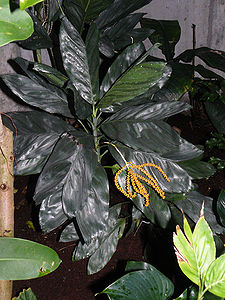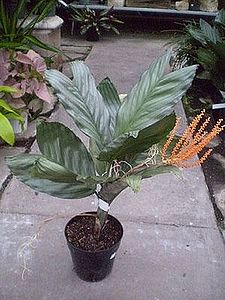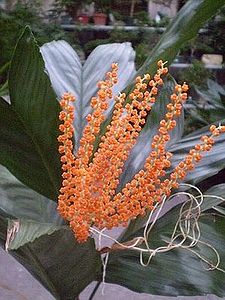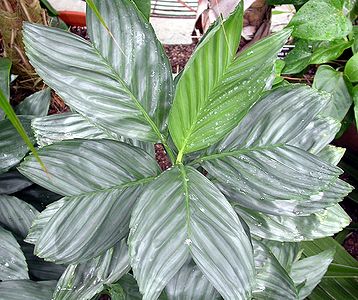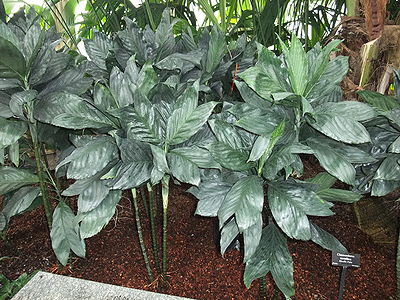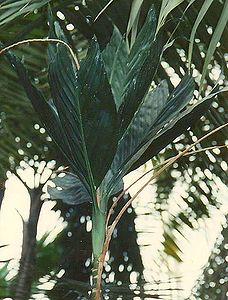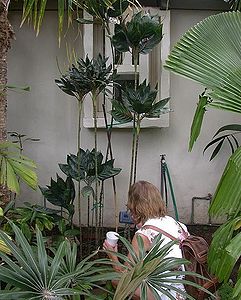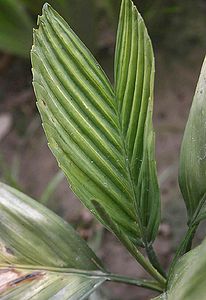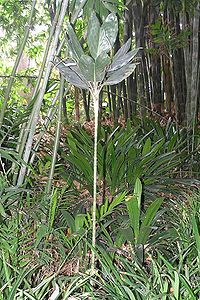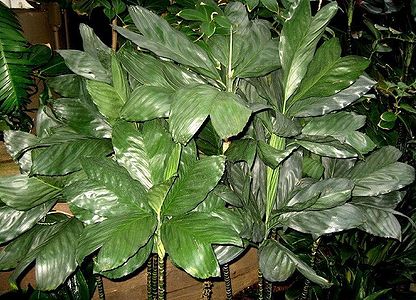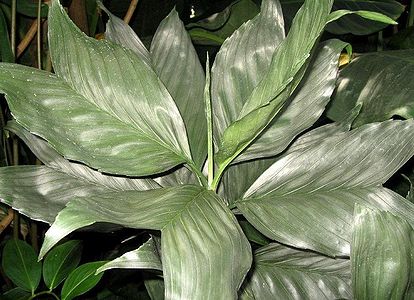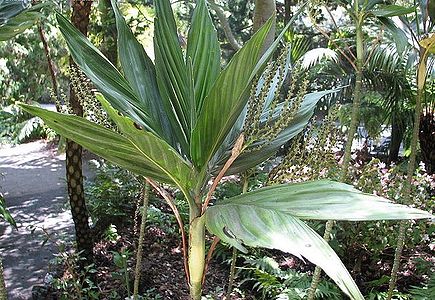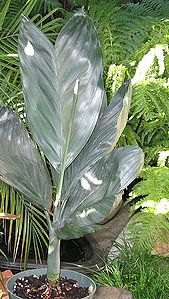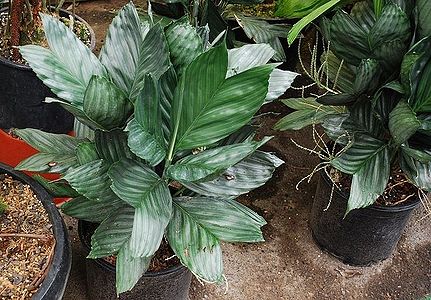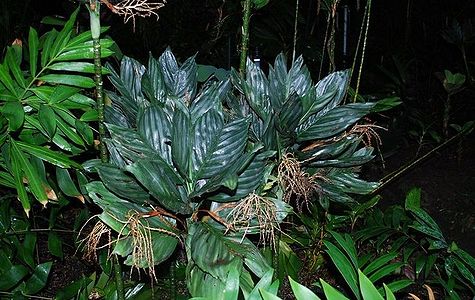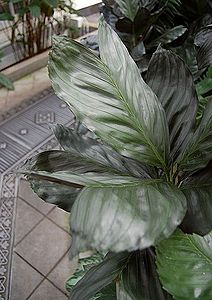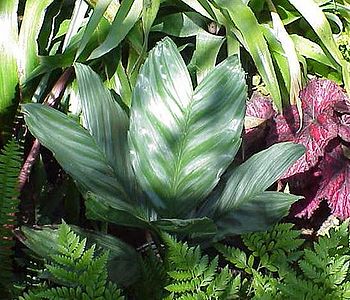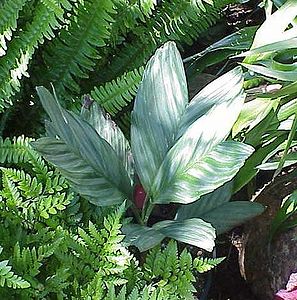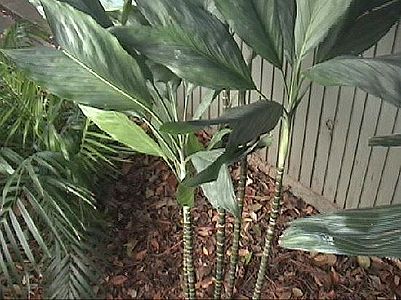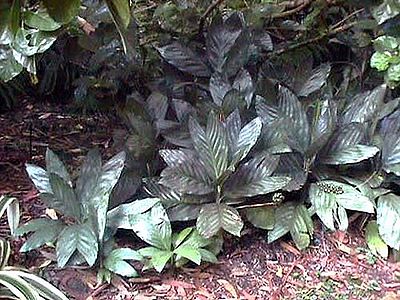Difference between revisions of "Chamaedorea metallica"
| Line 48: | Line 48: | ||
Special thanks to Geoff Stein, (Palmbob) for his hundreds of photos, edric. | Special thanks to Geoff Stein, (Palmbob) for his hundreds of photos, edric. | ||
| − | Special thanks to palmweb.org, Dr. John Dransfield, Dr. Bill Baker & team, for their volumes of information and photos, edric. | + | Special thanks to [http://palmweb.org/?q=node/2 Palmweb.org], Dr. John Dransfield, Dr. Bill Baker & team, for their volumes of information and photos, edric. |
Glossary of Palm Terms; Based on the glossary in Dransfield, J., N.W. Uhl, C.B. Asmussen-Lange, W.J. Baker, M.M. Harley & C.E. Lewis. 2008. Genera Palmarum - Evolution and Classification of the Palms. Royal Botanic Gardens, Kew. All images copyright of the artists and photographers (see images for credits). | Glossary of Palm Terms; Based on the glossary in Dransfield, J., N.W. Uhl, C.B. Asmussen-Lange, W.J. Baker, M.M. Harley & C.E. Lewis. 2008. Genera Palmarum - Evolution and Classification of the Palms. Royal Botanic Gardens, Kew. All images copyright of the artists and photographers (see images for credits). | ||
Revision as of 09:25, 2 August 2013
<google>CH02</google>
| Chamaedorea (kahm-eh-doh-REH-ah) metallica (meh-TAHL-lih-kah) | |||||||
|---|---|---|---|---|---|---|---|
 Split form. Photo by Geoff Stein, edric. | |||||||
| Scientific Classification | |||||||
| |||||||
| Synonyms | |||||||
|
| |||||||
| Native Continent | |||||||
|
| |||||||
| Morphology | |||||||
| |||||||
| Culture | |||||||
|
| |||||||
| Survivability index | |||||||
|
| |||||||
| Common names | |||||||
|
| |||||||
Contents
Habitat and Distribution
Mexico Gulf, Mexico Southwest. MEXICO, Veracruz, Oaxaca? Dense, wet forest on the Atlantic slope; alt. 50-600 m elevation; usually on limestone.
Native to Southeastern Mexico, where it occurs naturally in dense wet forests along the Atlantic limestone slopes, up to 2000 feet above sea level, and lowland rainforests of Veracruz and Oaxaca, Mexico.
Description
Habit: solitary, slender, erect, 2-3 m tall. Stem: 1.3-1.5 cm in diam., green, minutely but distinctly whitespotted, nodes prominent, internodes 1.5-2.5 cm long, adventitious roots often appearing at base. Leaves: 12-16 per crown, rather stiffly ascending or ascending-spreading with blades cupped upward toward apex, usually bifid but often variously pinnate, metallic-blue-green; sheath 7-8 cm long, tubular but split opposite petiole to within 1-2 cm of base; petiole 2.5-4 cm long, very slightly grooved and green above, rounded and pale below; rachis 19-32 cm long, angled and green above, rounded below with a yellowish band extending onto sheath; blade 20-30 x 15 cm, 10-12 cm long on upper margin, cuneate obovate, incised apically to 1/3 its length, 8-11 primary nerves on each side of rachis, these prominent but not much elevated above, impressed below, 5-6 secondaries between each pair of primaries, minutely and irregularly toothed along margin at apex of each primary nerve especially toward base; or, sometimes blade pinnate, pinnae 3-8 on each side of rachis, 2.5-6.5 cm wide, sigmoid, 1-3-nerved, toothed along outer margin above middle. Inflorescences: interfoliar but often infrafoliar in fruit, solitary, spreading-erect. Staminate with peduncle 10-25 cm long or more, pale or greenish in flower; bracts 3-4, lowermost 3 cm long, flattened, 2-edged, others 6-14 cm long, uppermost exceeding peduncle, all tubular, greenish, papery; rachis 4-6 cm long, pale or greenish in flower; rachillae 10-12, these 9-15 cm long, 1.5- 2 mm wide at base, simple, ascending to erect, usually flexuous at apex, pale green in flower. Pistillate spicate, sometimes furcate or with 3-4 rachillae; peduncle 12-26 cm long, green where exposed in flower, red-orange in fruit; bracts 6, similar to those of staminate, green in flower, brown in fruit; flower-bearing portion orrachillae 12-14 cm long, 4 mm in diam., erect, pale green in flower becoming swollen to 7 mm in diam. and red-orange in fruit. Flowers: Staminate in moderate spirals, 3 x 4 mm, depressed globose, dull purplish brown in bud, bright orange at anthesis, ± sunken in superficial elliptic depressions 1.5-2 mm long; calyx 1.25 x 2.25 mm, shallowly lobed, pale green to white, sepals connate in basal 1/., rounded to acute apically; petals 3 x 3 mm, connate in basal 1/2, valvate apically, bilobed, thick, fleshy, cupped over stamens; stamens nearly equalling petals, white, filaments 1.5-2 mm long, connate, adnate to pistillode, greenish, anthers essentially sessile on the filament tube, in curved, deeply bifid apically and basally, yellow; pistillode slightly exceeding petals, columnar with a broad flat 3-angled irregularly toothed cap apically, expanded basally, white. Pistillate in remote spirals, 3.5 x 3 mm, globose, bright orange, sunken I mm in axis, aromatic; calyx 1-1.5 x 2.75 mm, lobed, pale green, sepals imbricate in basal 1/2 rounded apically; petals 2-3 x 1.5 mm, connate briefly basally, valvate apically, thick, fleshy, strongly cup-shaped; staminodes 6, nearly as long as pistil, white; pistil 1.5-1.75 x 1.5 mm, depressed-globose, of 3 carpels connate in lower half but readily separable, pale green, stigma lobes sessile, recurved, clear-colored. Fruits: 12 x 9 mm, globose-ellipsoid when fresh, drying slightly smaller, dull black at maturity, epicarp smooth, mesocarp thin, fleshy, green with slender elongate or branched flat fibers appressed against thin endocarp; seeds 10 x 7 mm, brown, with 2 arcuately ascending raphe-branches. (Hodel, D.R. 1992)/Palmweb. Editing by edric.
O. F. Cook collected C. metallica as long ago as 1905 at Cordoba, Veracruz, Mexico. Cook also collected it from cultivated plants in St. Louis, Missouri, in 1907 and at the Doheny Estate in Los Angeles, California, in 1912 and 1914. Apart from Cook's collections, no specimens existed in herbaria and it seemed to have escaped the attention of horticulturists and botanists until the 1960s. In 1960, the late Horace Anderson of Leucadia, California, sent seeds he had collected in Mexico to Nat DeLeon in Miami, Florida, who forwarded some to H. E. Moore, Jr. at Cornell. Plants resulting from these seeds matured in 1965 at Cornell, were hand-pollinated, and produced fruits in 1966. Moore (1966) named the species from these plants. Cook had recognized C. metallica as a distinct species and suggested the epithet which Moore adopted when he formally named the species. In 1989, we found C. metallica growing on limestone rocks with C. elatior, C. sartorii, C. oblongata, and the cycad Dioon spinulosum near Temazcal, Veracruz. Local residents reported it to be very common on an island in Lake Temazcal. Despite being one of the most distinctive species of the genus due of its dark green, leathery leaves with a metallic sheen, C. metallica has been erroneously referred to C. tenella on several occasions in cultivation and the literature. In fact, Everett (1981, p. 73) illustrated and Lane (1988) listed C. metallica as C. tene/la. C. tenella, close to and possibly not distinct from C. geonomiformis, is uncommon in cultivation. C. tenella differs from C. metallica in the green blades lacking the metallic sheen; the spicate staminate inflorescence; and the yellow staminate flowers with the petals connate apically and the corolla opening by lateral slits. Although normally with bifid leaves, it is not unusual for C. metallica to have leaves that divide with age into 3-8 pairs of pinnae. Today, C. metallica is rather common and wide spread in cultivation and appears in gardens and collections in Europe, Australia, the Orient, Hawaii, California, Florida, Central America, and elsewhere. Seeds are handled commercially from both wild and cultivated plants in Mexico and distributed worldwide. Chamaedorea metallica is a handsome palm that, due to its dwarf habit and relatively slow rate of growth, makes an excellent subject for pots and tubs. It is a durable plant and relatively easy to grow. Extremely tolerant of low light, it performs exceedingly well indoors and is also very resistant to mites. (Hodel, D.R. 1992)/Palmweb.
Culture
Likes best: Full shade, to filtered light, this is an understory palm. Consistently moist soil, well drained position. Often planted in groupings. But will suffer drought, or lack of any care at all, for at least six months.
Comments and Curiosities
Chamaedorea are dioecious, male, and female flowers, on separate plants.
Etymology: Refers to the metallic blue-green sheen of the leaf.
The natural habitat is restricted to a this small area where it is very abundant, however it is now on the endangered species list due to the threat by the expansion of coffee plantations, increasing quarrying and timber cutting activities. This is usually most appreciated in cultivation as an under-story palm. The Metallica also makes an ideal houseplant. This fishtail-leafed Chamaedorea is unique in the genus for the beautiful, shiny blue-green metallic cast of its broad and it’s double lobed and a deep apical notched leaves sheen from which the plant derives its name. Metallica is very different than most palms with durable leaves that are truly metallic looking and the only known palm with leaves having a blue-green metallic sheen. The leaves grow almost straight up, reaching 12" long and up to 16" wide. There is also a variety that has pinnately compound with 4 to7 leaflets per side which can be linear or curved. The green stems (trunks) are white-spotted with swollen leaf rings and are up to 60 inches tall and up to 1" in diameter growing with a narrow profile. They prefer full shade but will tolerate early or late day sunshine and can be container grown easily. It is most striking when used in mass plantings. Naturally undemanding for nutrients, Metallica palm responds very well to regular applications of palm fertilizer. They thrive best in evenly moist rich well drained soil and should not be allowed to dry between waterings. Although this plant is on the endangered species list, it is widely cultivated and usually readily available or by special order at palm tree nurseries. They are quite tolerant of cold and can take temperatures as low as the mid 20s with no damage and still look very tropical. Metallic palm has attractive red, purple or orange flowers that yield small black fruits. This palm is a dioecious plant which requires both male and female to produce viable seed which should be planted within 6 weeks of maturity for best results and germination can still be erratic. The Metallica can also be propagated by division of the root mass. The elliptical fruits are about a half inch long. The flower stalk comes from the lowest leaves and the female has a characteristic orange stalk. Protect the foliage of this palm from snails. (Smithsonian Tropical Institute)
External Links
- Glossary of Palm Terms
- MODERN BOTANICAL LATIN
- "Just To Be Clear"
- http://itp.lucidcentral.org/id/palms/palm-id/Chamaedorea_metallica.htm
References
Phonetic spelling of Latin names by edric.
Special thanks to Geoff Stein, (Palmbob) for his hundreds of photos, edric.
Special thanks to Palmweb.org, Dr. John Dransfield, Dr. Bill Baker & team, for their volumes of information and photos, edric.
Glossary of Palm Terms; Based on the glossary in Dransfield, J., N.W. Uhl, C.B. Asmussen-Lange, W.J. Baker, M.M. Harley & C.E. Lewis. 2008. Genera Palmarum - Evolution and Classification of the Palms. Royal Botanic Gardens, Kew. All images copyright of the artists and photographers (see images for credits).
Hodel, D.R.1992. Chamaedorea Palms, The Species and Their Cultivation. The International Palm Society.
- IMAGE GALLERY
Many Special Thanks to Ed Vaile for his long hours of tireless editing and numerous contributions.







